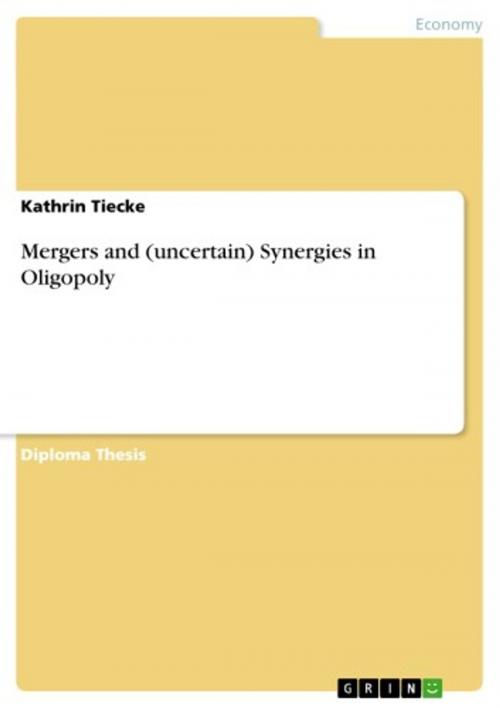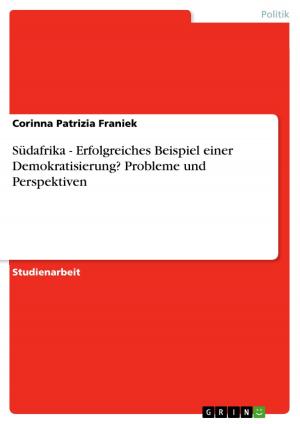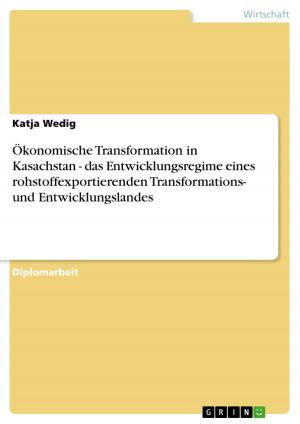| Author: | Kathrin Tiecke | ISBN: | 9783640928651 |
| Publisher: | GRIN Verlag | Publication: | May 31, 2011 |
| Imprint: | GRIN Verlag | Language: | English |
| Author: | Kathrin Tiecke |
| ISBN: | 9783640928651 |
| Publisher: | GRIN Verlag |
| Publication: | May 31, 2011 |
| Imprint: | GRIN Verlag |
| Language: | English |
Diploma Thesis from the year 2011 in the subject Economics - Micro-economics, grade: 2,0, Humboldt-University of Berlin (Wirtschaftstheorie II), course: VWL - Mikroökonomie, Industrial Organization, language: English, abstract: ...Farell and Shapiro state that there is no necessity for mergers as cooperation and coordination can be achieved at an equivalent level via contracts: '..., modern economic theory observes that virtually anything that can be done with a merger can in principle be done instead with some kind of contract, perhaps a very complex (or restrictive) one.' (Farrell and Shapiro 2001, p. 691)... 6.2 Concluding Remarks ...In the last section I introduce the strand of economic literature that deals with the process of mergers under uncertain efficiency gains. By introducing uncertain synergies to Cournot merger models the merger paradox can be solved in all above presented approaches and compared to the deterministic models there is a wider scope of profitable mergers. The informational asymmetry after the merger benefits the merger members although efficiency gains may be not obtained post merger. Thus mergers are more likely to be beneficial compared to the case where uncertain efficiency gains are not assumed. It has been shown that the incentives to merger coincide with the degree of uncertainty and when firms are aware of this uncertainty they are able to prepare for the post-merger integration process much better since post-merger actions can be specified more accurately. Any merger with uncertain synergies that needs to be approved by competition agencies can positively affect the approval by evaluating the uncertain efficiency gains with the required post-merger process... ...this may be an attempt to replicate the merger failures in the real world. To analyze further the role of uncertain synergies, models that depart from the one-shut nature should be implemented. This might give insights why merger formations appear wavelike and if the equilibrium changes when non-merged firms adjust as soon as they observe the true type of their (new) rival. As the world has become realistically more transparent the unmerged firms may observe rather fast whether they face a more or less efficient rival and so the time horizon should ex ante alter the expected profits of the market players compared to the one-shot nature of the standard Cournot game. The question what types of firms, the most or the least efficient ones are involved in a merger remains unanswered as there are ambiguous results in the theory of endogenous merger formation. The empirical observations also do not support the theory that low-performing firms are the preferred target for acquisitions.
Diploma Thesis from the year 2011 in the subject Economics - Micro-economics, grade: 2,0, Humboldt-University of Berlin (Wirtschaftstheorie II), course: VWL - Mikroökonomie, Industrial Organization, language: English, abstract: ...Farell and Shapiro state that there is no necessity for mergers as cooperation and coordination can be achieved at an equivalent level via contracts: '..., modern economic theory observes that virtually anything that can be done with a merger can in principle be done instead with some kind of contract, perhaps a very complex (or restrictive) one.' (Farrell and Shapiro 2001, p. 691)... 6.2 Concluding Remarks ...In the last section I introduce the strand of economic literature that deals with the process of mergers under uncertain efficiency gains. By introducing uncertain synergies to Cournot merger models the merger paradox can be solved in all above presented approaches and compared to the deterministic models there is a wider scope of profitable mergers. The informational asymmetry after the merger benefits the merger members although efficiency gains may be not obtained post merger. Thus mergers are more likely to be beneficial compared to the case where uncertain efficiency gains are not assumed. It has been shown that the incentives to merger coincide with the degree of uncertainty and when firms are aware of this uncertainty they are able to prepare for the post-merger integration process much better since post-merger actions can be specified more accurately. Any merger with uncertain synergies that needs to be approved by competition agencies can positively affect the approval by evaluating the uncertain efficiency gains with the required post-merger process... ...this may be an attempt to replicate the merger failures in the real world. To analyze further the role of uncertain synergies, models that depart from the one-shut nature should be implemented. This might give insights why merger formations appear wavelike and if the equilibrium changes when non-merged firms adjust as soon as they observe the true type of their (new) rival. As the world has become realistically more transparent the unmerged firms may observe rather fast whether they face a more or less efficient rival and so the time horizon should ex ante alter the expected profits of the market players compared to the one-shot nature of the standard Cournot game. The question what types of firms, the most or the least efficient ones are involved in a merger remains unanswered as there are ambiguous results in the theory of endogenous merger formation. The empirical observations also do not support the theory that low-performing firms are the preferred target for acquisitions.















